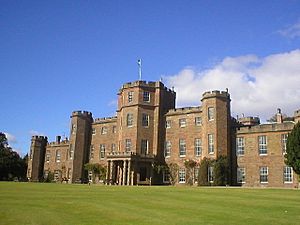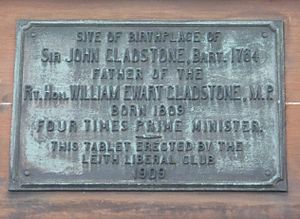Sir John Gladstone, 1st Baronet facts for kids
Quick facts for kids
John Gladstone
Bt FRSE
|
|
|---|---|
 |
|
| Member of Parliament for Lancaster |
|
| In office 1818–1820 |
|
| Preceded by | John Fenton-Cawthorne |
| Succeeded by | John Fenton-Cawthorne |
| Member of Parliament for Woodstock |
|
| In office 1820–1826 |
|
| Preceded by | Sir Henry Dashwood |
| Succeeded by | Marquess of Blandford |
| Member of Parliament for Berwick-upon-Tweed |
|
| In office 1826–1827 |
|
| Preceded by | Sir Francis Blake |
| Succeeded by | Sir Francis Blake |
| Personal details | |
| Born |
John Gladstones
11 December 1764 Leith, Midlothian |
| Died | 7 December 1851 (aged 86) Fasque House, Kincardineshire |
| Resting place | St. Andrew's Chapel, Kincardineshire |
| Political party | Tory |
| Spouses | Jane Hall (m. 1792–1798) Anne MacKenzie Robertson (m. 1801–1835) |
| Children | |
| Parents |
|
Sir John Gladstone, 1st Baronet (born December 11, 1764 – died December 7, 1851) was a Scottish businessman and politician. He is most famous for being the father of William Ewart Gladstone, who later became a British Prime Minister.
John Gladstone was born in Leith, Scotland. Through his business activities, he became the owner of several large farms, called plantations, in British colonies like Jamaica and Demerara-Essequibo. These plantations used the forced labor of enslaved people.
One of the biggest revolts by enslaved people in the British Empire, the Demerara rebellion of 1823, started on one of Gladstone's plantations. When slavery was finally ended by the Slavery Abolition Act 1833, the British government paid money to former slave owners. John Gladstone received the largest payment of anyone, as he owned so many enslaved people.
After slavery ended, Gladstone brought many people from India to work on his plantations. He promised them schools and medical care, but these promises were often broken. The workers were paid very little or nothing, and their living and working conditions were very harsh, similar to slavery.
John Gladstone was also a Member of Parliament (MP) from 1818 to 1827. His involvement in slavery greatly influenced his son William's early political views.
Contents
Early Life and Moving to Liverpool
John Gladstones was born in Leith, Scotland. He was the second of sixteen children. His father, Thomas Gladstones, was a merchant.
John left school at age 13 in 1777. He described his education as very basic, focusing on reading, writing, and math. He then started an apprenticeship at a rope-making company in Leith.
After finishing his training in 1781, he joined his father's business. They traded in grain and flour. John's father knew that bigger opportunities were available in cities like Liverpool.
In 1784, John traveled to German ports to buy grain. In 1786, he visited Liverpool, Manchester, and London to sell his father's goods.
In 1787, John Gladstones decided to move to Liverpool with his father's financial help. Once he settled there, he dropped the "s" from his last name, becoming John Gladstone. This change was made official in 1835.
He quickly joined a business partnership with other grain merchants. Their company, Corrie, Gladstone & Bradshaw, grew very successful. John Gladstone even spent a year in the United States, buying various goods like wheat, tobacco, and timber.
Family Life
In 1792, John Gladstone married Jane Hall, who was also from Liverpool. She had poor health and passed away in 1798. They did not have any children.
On April 29, 1800, he married Anne Mackenzie Robertson in Liverpool. She was the daughter of a lawyer and a local leader from Scotland. John and Anne had six children together:
- Anne Mackenzie Gladstone (1802–1829)
- Sir Thomas Gladstone, 2nd Baronet (1804–1889)
- Robertson Gladstone (1805–1875)
- John Neilson Gladstone (1807–1863)
- William Ewart Gladstone (1809–1898)
- Helen Jane Gladstone (1814–1880)
Around 1804, John Gladstone and his family began attending the Church of England. In 1813, the family moved out of the city center to a large home called Seaforth House. This estate included a mansion, a farm, and a small village.
At Seaforth, John Gladstone built St. Thomas's Anglican Church in 1815. He also built St. Andrew's Episcopal Church in Liverpool, which had a school for poor children.
Business Ventures
In 1801, John Gladstone's first business partnership ended. He then started his own company, John Gladstone & Company. His brother Robert joined him, and eventually all six of his brothers moved to Liverpool to work in different businesses.
John Gladstone's company became very large. They traded extensively with Russia and were major importers of sugar. In 1814, his firm was the first private company to send a ship to Calcutta, India, after trade rules changed.
He also invested in property, building houses in Liverpool and buying land outside the city. He made a lot of money trading corn with the United States and cotton with Brazil.
John Gladstone and Slavery
John Gladstone owned large sugar plantations in Jamaica and Demerara. He was also the Chairman of the West India Association, a group representing plantation owners.
In 1823, a huge revolt by enslaved people, known as the Demerara rebellion of 1823, happened on his plantation in Demerara-Essequibo (which is now part of Guyana). The leader of this revolt was an enslaved man named Jack Gladstone, who worked on John Gladstone's "Success" plantation. Enslaved people often took the last names of their owners. The revolt was put down very harshly by the army.
After slavery was abolished in the British Empire by the Slavery Abolition Act 1833, the government paid money to former slave owners. John Gladstone received the largest payment of anyone. He owned 2,508 enslaved people in British Guiana and Jamaica. He received a payment of £106,769.
After slavery ended, John Gladstone looked for new workers for his sugar plantations. He brought people from India to work under contracts, known as indentured laborers. He wrote that the work was easy and conditions were good, promising schools and medical care. However, the reality was very different. The workers were often not paid, and their living and working conditions were very poor, similar to slavery. Many workers tried to escape.
Political Career
John Gladstone was also interested in politics. He started as a Whig but later became a Tory. His friendships with important Tory politicians like George Canning influenced his change in views.
In 1817, John Gladstone decided to become a Member of Parliament (MP). He was elected to represent Lancaster in 1818. He later represented Woodstock and Berwick-upon-Tweed.
He didn't give many speeches in Parliament. However, he was known for his good work in committees and was considered very knowledgeable about business and trade. He supported some reforms to voting rights and also supported Greek independence in the 1820s.
In 1827, he lost his seat for Berwick-upon-Tweed. This happened after people complained that his election involved bribery and illegal votes. He tried to return to Parliament in 1837 but was defeated.
Later Life
Around 1820, John Gladstone started looking for an estate in his home country of Scotland. In 1829, he bought the Fasque Estate in Kincardineshire for £80,000. He decided to move back to Scotland with his family. Only his son, Robertson, stayed in Liverpool to manage the family business.
The family left Seaforth in 1830. They lived in other towns for a few years, seeking better health for Mrs. Gladstone and their daughter Helen. They finally moved into Fasque House in the summer of 1833.
In 1838, John Gladstone used his wealth to fund several good causes in his hometown of Leith. These included St. Thomas's Church, schools for boys and girls, and a home for sick women.
In 1846, John Gladstone was given the title of baronet by the Prime Minister, Sir Robert Peel. This meant he became "Sir John Gladstone, 1st Baronet."
Sir John Gladstone died at Fasque House in December 1851, just before his 87th birthday. He was buried at St. Andrew's Episcopal Church at Fasque. His eldest son, Sir Thomas Gladstone, 2nd Baronet, inherited his title.
Memorials
A plaque was put up in 1909 in Leith to mark the place where John Gladstone was born.
There is also a street called Gladstone Place on Leith Links and a pub called "Gladstones" in Leith, both named in his honor.
See also
- Jack Gladstone




